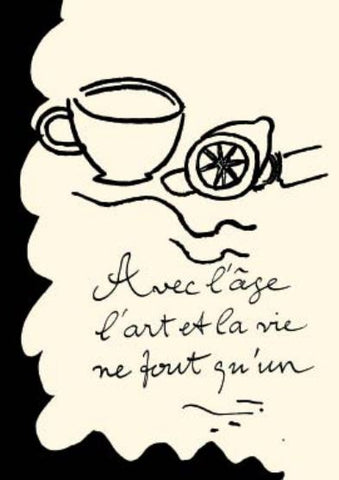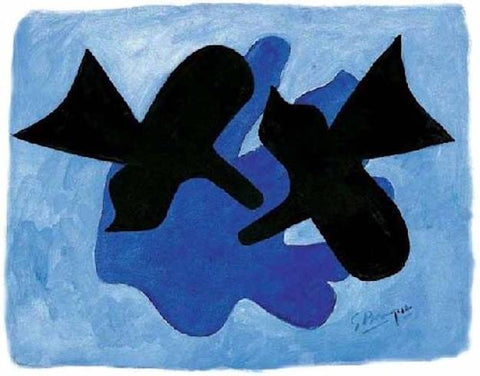.Braque
 The Bird in the Foliage, 1962, original lithograph, 80x105 cm, Maeght Éditeur, Paris.
The Bird in the Foliage, 1962, original lithograph, 80x105 cm, Maeght Éditeur, Paris.
It was Braque who advised the Maeghts to show Derain's works. Aimé admired not only the man, his spirit and his rigor, but also his work and his sense of the profession. Not a single shadow will tarnish their deep friendship. Aimé buys all of the artist's production and encourages him to find his way back to the lithography workshops.
 Aimé Maeght and Georges Braque, 1954
Aimé Maeght and Georges Braque, 1954
Aimé takes over the edition of the plates engraved by Braque for Ambroise Vollard illustrating Hesiod's Theogony as well as prints of Cubist engravings from the 1900s.
In the 1950s, Braque focused on painting his famous Workshop series, but also large rural landscapes in panoramic formats: abandoned plows in a wheat field, flocks of birds above the plain... He also reconnected with the marines, from the seaside, from the boats on the shore whose impasto can seem heavy; the paint overflows and even invades the frame... The gaze narrows on the painting. His latest paintings give a feeling of vertigo. “ I am concerned to put myself in unison with nature, much more than to copy it,” he notes in his Notebook that Maeght published in 1947.
 Page from Georges Braque's Notebook, 1917-1947, Maeght Éditeur, Paris
Page from Georges Braque's Notebook, 1917-1947, Maeght Éditeur, Paris
Rigor combines with invention dominated by reflection. All his painting is contained in this sentence that he hammered out: “We must be content to discover, but be careful not to explain.” In Varengeville, where he lives and works, and where during the “phoney war” Alexander Calder, Joan Miró and his family joined him, Braque knew how to capture the harsh and changing light.
 Georges Braque creating, in the Louvre reserves, the ceiling of the Etruscan room, 1952.
Georges Braque creating, in the Louvre reserves, the ceiling of the Etruscan room, 1952.
As a family, the Maeghts regularly meet the painter and his wife Marcelle in this village on the Normandy coast. Then Georges Braque returned to settle in Paris, where Paule, Adrien's wife, visited him daily.
 Marguerite Maeght, Georges and Marcelle Braque in Venice in 1948.
Marguerite Maeght, Georges and Marcelle Braque in Venice in 1948.
 Georges Braque working on an extraordinary canvas, in fact, it was necessary to make a very particular frame to make this arch shape at the request of my grandfather, Aimé Maeght, in order to adorn a room in his farmhouse in Saint -Paul de Vence.
Georges Braque working on an extraordinary canvas, in fact, it was necessary to make a very particular frame to make this arch shape at the request of my grandfather, Aimé Maeght, in order to adorn a room in his farmhouse in Saint -Paul de Vence.
Here is Georges Braque installing this splendid painting.
He himself painted the underside of the arch to continue the sky…
Two white birds, like a diptych in a single canvas. We look up to see them, we fly with them...
Georges Braque, The couple of birds,
“ Braque is patient. His face, so humble that it seems to have seen peace. But the shoulder is of a lumberjack; and the size of a giant. “You have to have time,” he said, “to think about it.” Indeed, he sits down. Then: "When I was young, I didn't imagine that we could paint without a model. It came to me little by little. To make a portrait! And of a woman in an evening dress, for example. No , I don't have a domineering enough spirit." He explains: "Portraiture is dangerous. You have to pretend to think about your model. You hurry. You answer before the question is even asked. You have ideas." By Jean Paulhan
 Georges Braque, Landscape at l'Estaque, Autumn, 1906.
Georges Braque, Landscape at l'Estaque, Autumn, 1906.
 Georges Braque, Still life with glass and letters, 1914.
Georges Braque, Still life with glass and letters, 1914.
 Georges Braque, “Still life with pink fish”, 1937.
Georges Braque, “Still life with pink fish”, 1937.
Symmetry is created by intensities rather than shapes. And the background, crazy and so bold.
Georges Braque, "Mandolin", 1941. This painting still has so much to teach us. This impression of verticality is wonderful even though the canvas is almost square.
 Georges Braque, “A tire of wing”, 1956-1961.
Georges Braque, “A tire of wing”, 1956-1961.
A great friendship united the man whom Jean Paulhan nicknamed “the boss” with Jacques Prévert, who dedicated these few verses to him:
Braque
what was he thinking
when was he thinking
in front of the sea this naked model.
Georges Braque, The Black Birds, 1956 - 1957, oil on canvas, 181 x 229 cm.“Children and geniuses know that there is no bridge, only water that can be crossed. Also for Braque the source is inseparable from the rock, the fruit of the soil, the cloud of its destiny, invisibly and sovereignly. The incessant coming and going from solitude to being and from being to solitude melts before our eyes the biggest heart there is. Braque thinks that we need too many things to be satisfied with one thing, therefore we must ensure, at all costs, the continuity of creation, even if we must never benefit from it. In our concrete world of resurrection and anxiety of non-resurrection, Braque assumes the perpetual. He has no apprehension of future quests although he is concerned about the forms to be born. He will always put a man in them! » - René Char, Behind the Mirror, 1957
Georges Braque in the Louvre reserves
“Braque was a craftsman who always kept this character with this restraint and this nobility of love of the profession. » - Aimé Maeght
When he died in 1963, he was given a national funeral. His friend André Malraux, who had commissioned him to decorate a ceiling in the Louvre Museum, delivered the eulogy in front of the museum. The painter is buried privately in the small cemetery of Varengeville, whose chapel is decorated with his stained glass windows.





